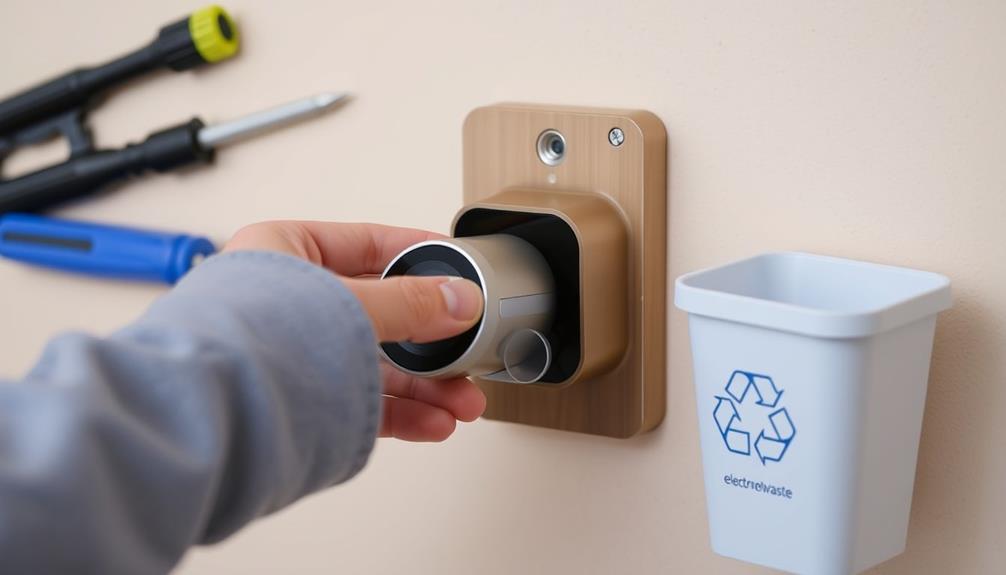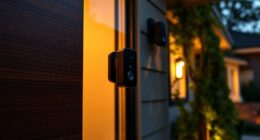In order to set up your Ring doorbell to work alongside your current doorbell, first turn off the power supply at the circuit breaker. Remove the wires from your old doorbell and attach them to the Ring Video Doorbell as instructed in the manual. If you have a mechanical chime, you may require a jumper wire to ensure proper compatibility. Make sure your transformer has a minimum capacity of 50VA. Once all connections are secure and power is restored, test to confirm that everything is working properly. If you encounter any difficulties, there are additional tips and solutions available to help guide you in the right direction.
Key Takeaways
- Ensure your existing doorbell transformer has a minimum capacity of 50VA and outputs at least 8V 1A for proper functionality.
- Follow the installation manual to securely connect the Ring doorbell wires and bypass any incompatible mechanical chimes with a jumper.
- Double-check all wiring connections to prevent malfunctions; loose or damaged wires can lead to power issues.
- Consider using a Ring Chime for indoor notifications if your existing chime is incompatible or requires bypassing.
Installation Process Overview
To successfully install your Ring Video Doorbell with an existing doorbell, you'll need to hardwire it to the existing doorbell circuit and confirm proper connections to both the doorbell and transformer.
Start by turning off the power to your existing doorbell at the circuit breaker to guarantee safety during installation. It's also beneficial to take into account using a reliable garage door opener for enhanced security around your home.
Next, remove the cover of your existing doorbell and disconnect the wires. Connect these wires to your Ring Video Doorbell, confirming you follow the manufacturer's instructions for proper installation.
If your existing doorbell has a mechanical chime, you may need to add a jumper to bypass it, as not all chimes are compatible with the Ring Video Doorbell. The installation manual will provide the correct placement for the jumper, which can vary by model.
After making the connections, secure everything back in place and restore power to the circuit.
It's essential to test the functionality of your new installation by pressing the doorbell and confirming the old chime rings as expected. This step guarantees that your Ring Video Doorbell is fully operational and integrated with your existing doorbell system.
Transformer Capacity Requirements

Understanding the transformer capacity is essential for guaranteeing your Ring Video Doorbell gets the power it needs to function properly with your existing doorbell system. A transformer with at least 50VA capacity is typically recommended for dual operation, allowing both your Ring doorbell and the existing chime to work seamlessly.
Additionally, considering the essential kitchen gadgets that enhance your home can improve overall functionality, just like guaranteeing your doorbell system operates smoothly.
If your transformer capacity is too low, it may struggle to supply sufficient power, leading to functionality issues. To avoid this, always check the transformer label for its specifications. Transformers with less than 8V 1A output don't meet the minimum requirement for the Ring doorbell, which can cause compatibility issues.
If you find that your current transformer isn't up to par, consider upgrading to a higher capacity option. This won't only resolve any compatibility issues but also guarantee that both your Ring doorbell and existing chime operate effectively.
Chime Compatibility Considerations

When setting up your Ring doorbell, you'll need to take into account the type of existing chime you have, as not all chimes are compatible.
Some modern energy-efficient options can enhance your home's ambiance while guaranteeing compatibility with smart devices.
If you're using a mechanical chime, you might've to bypass it to ascertain proper functionality.
Plus, it's essential to check your transformer's power capacity to avoid any compatibility issues.
Existing Chime Types
Selecting the right chime is essential for guaranteeing your Ring doorbell functions properly with your existing setup. If you're using a mechanical chime, you should know that certain models, like the Ring Video Doorbell Wired, aren't compatible. In these cases, you'll need to bypass the existing chime to allow the doorbell to operate effectively.
For those with compatible chimes, like the Ring Video Doorbell Pro, your existing chime can work seamlessly with the doorbell, ringing when someone presses it. However, to achieve this compatibility, you might need to make some adjustments during installation, such as adding a jumper wire.
If you prefer not to deal with mechanical chimes, you have alternatives. The Ring Chime and Ring Chime Pro provide indoor notification options that don't require a mechanical chime. These devices connect directly to your Wi-Fi, guaranteeing you never miss a visitor, regardless of your existing setup.
Before proceeding with installation, double-check the compatibility of your existing chime to avoid any issues. Proper planning will guarantee a smooth integration of your Ring doorbell into your home.
Bypassing Mechanical Chimes
Bypassing mechanical chimes is essential for ensuring your Ring doorbell operates smoothly if your existing chime isn't compatible. The Ring Doorbell Wired doesn't support traditional chimes, so you'll need to bypass them to make sure your doorbell gets the power it needs.
To do this, you might require a jumper, which is a simple wire connection that allows the doorbell to function without the existing chime. The installation manual provides detailed instructions on where to place the jumper, so be sure to follow it carefully to avoid any issues.
If you have a Friedland Cathedral 300/98 chime, keep in mind that it requires specific wiring for compatibility, which could involve additional configuration.
Should your current chime prove incompatible, consider using a Ring Chime or Ring Chime Pro. These devices don't need chime bypassing and will notify you indoors when someone rings your doorbell.
Lastly, remember that transformer capacity is vital. A 50VA transformer usually suffices for dual operation, while lower capacity transformers might struggle to power both the Ring doorbell and any existing chime.
Transformer Power Requirements
Verifying your transformer meets the right power requirements is key to making both your Ring doorbell and existing chime work together effectively.
Your transformer must have a minimum capacity of 8V 1A to guarantee the Ring Video Doorbell Wired functions correctly. If the power supply isn't sufficient, you could run into compatibility issues that prevent the doorbell from ringing your chime.
For peak performance, especially if you want both the Ring doorbell and your existing chime to operate simultaneously, it's advisable to use a transformer with a minimum capacity of 50VA. Lower capacity transformers mightn't provide enough power for both devices, leading to malfunctions or even failure to ring the chime when the doorbell is pressed.
Before installation, always check the transformer label for specifications to confirm it meets these requirements. If you experience persistent power issues, upgrading to a higher capacity transformer may resolve these problems and enhance the overall functionality of your Ring doorbell and existing chime setup.
Don't overlook this vital step, as proper transformer capacity is essential for seamless operation.
Jumper Setup Instructions

To set up the jumper correctly, follow the specific instructions in your Ring doorbell installation manual. This jumper is vital for bypassing certain existing chimes, allowing your doorbell to receive adequate power. Confirm to double-check the placement; improper installation might prevent your mechanical chime from ringing when the doorbell is pressed.
Here's a quick reference table to help you with the jumper setup:
| Step | Action | Notes |
|---|---|---|
| 1. Verify Transformer | Check transformer capacity | Should be 50VA or higher |
| 2. Locate Jumper | Find jumper location in installation manual | Model-specific |
| 3. Install Jumper | Place jumper according to manual | Avoid compatibility issues |
If your existing chime isn't functioning post-installation, consider removing the jumper to see if it restores operation. However, be cautious, as this might affect the power supply to the doorbell. Always refer back to the installation manual for the best results and to confirm compatibility with your existing chimes.
Troubleshooting Common Issues

If you're having trouble with your Ring Video Doorbell, start by checking your wiring connections to guarantee everything's secure.
Next, verify that your transformer is compatible and functioning properly.
Wiring Connection Verification
Secure wiring connections between the Ring Video Doorbell and your existing doorbell circuit are essential for preventing power issues.
First, double-check that all wiring connections are firm and correctly attached. Loose or improperly connected wires can lead to malfunction.
Next, verify the compatibility of your existing chime with the Ring doorbell. If you have a mechanical chime, it may not be supported and might need to be bypassed entirely.
If your chime is compatible, inspect the placement of any required jumpers. Incorrect jumper placement can prevent the chime from ringing, causing confusion during installation troubleshooting.
Additionally, verify that the transformer output is at least 8V 1A. Insufficient power can lead to issues with the Ring doorbell's functionality.
If you're still facing problems, consider utilizing community forums. Many users share insights and solutions for common wiring issues that you might encounter during installation.
Transformer Output Check
Check the transformer output to verify it delivers at least 8V 1A, as insufficient power can hinder your Ring Video Doorbell's performance. To ascertain proper functionality, inspect the transformer label for its specifications. A transformer rated at 50VA should suffice for running both your Ring doorbell and an existing chime.
Use a multimeter to measure the voltage output at the transformer. If your readings fall below the required specifications, that's a clear indicator that troubleshooting is necessary. Also, examine the wiring connections to the transformer. Loose or damaged wires can result in inadequate power reaching your doorbell, which can lead to frustrating performance issues. If you discover that the transformer output is indeed low, consider upgrading to a higher capacity transformer to ascertain a reliable power supply.
Here's a quick reference table to help you:
| Voltage Output | Current Requirement | Action Needed |
|---|---|---|
| Below 8V | Insufficient power | Upgrade transformer |
| 8V – 10V | Proper functionality | No action needed |
| Above 10V | Proper functionality | No action needed |
| 50VA | Dual operation | No action needed |
| Check wiring | Loose connections | Repair as needed |
Community Forum Solutions
Many users have found that engaging in community forums can uncover effective troubleshooting solutions for common issues with Ring doorbells and existing chimes.
When you run into problems, these forums can be a goldmine for advice and shared experiences. For instance, some users have successfully bypassed old mechanical chimes by using a jumper during setup, ensuring the Ring doorbell receives the necessary power.
One recurring theme in discussions is the importance of checking the transformer capacity. Users recommend a 50VA transformer to support both the Ring doorbell and your existing chime simultaneously. If your chime isn't ringing, it might signal wiring issues or that you need a more powerful transformer.
Additionally, many troubleshooting tips emphasize verifying wiring connections, as improper installations can lead to mechanical humming or complete chime failure.
By participating in these community forums, you can gain valuable insights into these common electrical issues and discover effective solutions tailored to your specific setup.
Don't hesitate to ask questions; you'll likely find others who've faced similar challenges.
Notification Options Explained

When someone presses your Ring Doorbell, you'll receive mobile notifications through the Ring app, keeping you informed no matter where you are. If you have the Video Doorbell Pro, the Ring app will adjust to guarantee you get timely alerts. This feature allows you to receive notifications directly on your smartphone or tablet, making it easy to stay updated while you're out and about.
For those who prefer in-home doorbell chimes, you can connect a Ring Chime. This device will provide a sound notification whenever someone rings your doorbell, allowing you to hear alerts throughout your home. Additionally, you can link your Ring devices to Alexa for hands-free announcement notifications, enhancing your alert system.
The Ring app also offers customize options, so you can tailor your notifications to fit your lifestyle. You can choose to receive alerts for motion detection, doorbell presses, or both, guaranteeing you're only notified about what's most important to you.
With these features, your Ring Doorbell can seamlessly integrate into your daily routine, keeping you connected and informed about visitors.
Community Insights and Support

Active participation in community forums can greatly enhance your understanding of how to successfully wire your Ring Doorbell with existing setups. Many users share their experiences about bypassing existing mechanical chimes, which is vital for your doorbell to function properly.
These discussions often emphasize the importance of checking your transformer capacity; remember, it needs to be at least 8V 1A to provide adequate power.
Consulting installation guides is another valuable resource. Users frequently post photos of their wiring configurations, which can help you visualize the setup and troubleshoot issues that may arise during installation.
Engaging with others in these forums allows you to learn from their unique challenges and solutions, making your installation process smoother.
If you run into problems or have specific questions, don't hesitate to reach out for help. Many users have found that contacting Ring support through community channels leads to personalized assistance.
Whether you're looking for clarification on installation questions or troubleshooting issues, the collective knowledge in these forums can be an invaluable asset in ensuring your Ring Doorbell works seamlessly with your existing system.
Additional Help Resources

To guarantee a smooth installation of your Ring Doorbell, you can access a variety of additional help resources tailored specifically for integrating it with your existing doorbell system.
Start by visiting the Ring Help Center, where you'll find detailed articles, wiring diagrams, and compatibility information that can guide you through the process.
If you prefer visual support, explore the video tutorials available on the Ring website. These videos offer step-by-step guidance for both installation and troubleshooting, making it easier to understand what you need to do.
You can also download the Ring app, which provides helpful tips and additional resources right at your fingertips.
Don't forget about the community forums, where you can find user-shared solutions and experiences related to integrating Ring Doorbells with mechanical chimes and transformers.
If you run into any issues, refer to the troubleshooting guides specifically designed for Ring devices to help you resolve common problems.
Frequently Asked Questions
Will Ring Doorbell Work With Existing Doorbell?
Yes, your Ring Doorbell can work with an existing doorbell, but it depends on a few factors.
If you have a compatible transformer and your doorbell isn't a traditional mechanical chime, it should function properly.
You'll need to bypass the chime kit during installation if that's the case.
For some models, like the Video Doorbell Pro, check for compatibility with your current setup to guarantee everything runs smoothly.
How Do I Make My Existing Doorbell Work With Ring?
Picture your home as a symphony, each doorbell chime a note in perfect harmony.
To make your existing doorbell work with Ring, first verify your chime's compatible. You might need to bypass the old chime with a jumper wire.
Check that your transformer's output meets the requirements.
Then, enter the Ring app to enable Automatic Chime Detection.
If it doesn't ring, revisit your wiring and seek advice from fellow enthusiasts.
How Do I Add a Ring Doorbell That Is Already Installed?
To add your already installed Ring Doorbell, open the Ring app and go to the device menu.
Select "Set Up a Device" and follow the prompts.
Make sure your existing wiring meets the required specifications, typically 8V 1A or higher.
If you bypassed your chime, you might need to adjust the wiring for it to work with your Ring Doorbell.
Use the Automatic Chime Detection feature to help configure your setup.
Is It Possible for a Doorbell to Ring on Its Own?
Imagine a charming home, where the doorbell chimes like an inviting melody. Yes, a doorbell can ring on its own!
When properly wired, it activates automatically when someone presses the button.
However, if the wiring or transformer isn't compatible, it mightn't work as intended.
Can I Use My Existing Chime with the Ring Doorbell?
Yes, you can use your existing chime with the Ring Doorbell through the ring doorbell existing chime integration. This allows your doorbell to work alongside your current chime system, providing you with the convenience of hearing the doorbell throughout your home.
Conclusion
By integrating your Ring Doorbell with your existing system, you can enhance your home security effortlessly.
Did you know that homes with video doorbells can reduce package theft by up to 50%?
With the right installation steps, transformer capacity, and chime compatibility, you'll enjoy seamless operation and peace of mind.
Don't hesitate to explore the troubleshooting tips and community insights — you're not alone in this journey to smarter home security!









